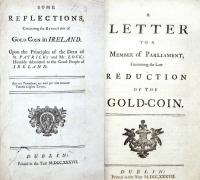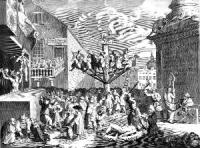‘Hang up half a dozen bankers’:attitudes to bankers in mid-eighteenth-century Ireland
Published in 18th–19th - Century History, Early Modern History (1500–1700), Features, Issue 5 (Sept/Oct 2012), Volume 20![Jonathan Swift—depicted here, ironically, on the old £10 note. Some of the strongest attacks came from Swift, already a notorious political commentator following his publication of controversial works such as Proposal for the universal use of Irish manufactures and Drapier’s letters, provoked by the controversy surrounding the production of Wood’s halfpence and farthings. Swift was scathing in his attack on bankers in 1728, describing them as ‘a necessary evil in a trading country, but so ruinous in ours, who for private advantage have sent away all our silver, and one third of our gold’. He also sarcastically expressed his desire for a law to be enacted to ‘hang up half a dozen bankers every year, and thereby interpose [at] least some short delay to the further ruin of Ireland’. (Central Bank of Ireland)](https://www.historyireland.com/wp-content/uploads/2013/03/Hang-up-half-a-dozen-bankers-attitudes-to-bankers-in-mid-eighteenth-century-Ireland-1.jpg)
Jonathan Swift—depicted here, ironically, on the old £10 note. Some of the strongest attacks came from Swift, already a notorious political commentator following his publication of controversial works such as Proposal for the universal use of Irish manufactures and Drapier’s letters, provoked by the controversy surrounding the production of Wood’s halfpence and farthings. Swift was scathing in his attack on bankers in 1728, describing them as ‘a necessary evil in a trading country, but so ruinous in ours, who for private advantage have sent away all our silver, and one third of our gold’. He also sarcastically expressed his desire for a law to be enacted to ‘hang up half a dozen bankers every year, and thereby interpose [at] least some short delay to the further ruin of Ireland’. (Central Bank of Ireland)
Coin shortages
Pamphleteers accused bankers of exploiting Ireland’s economic problems for private gain. In particular, the coin shortages that plagued the country during these years were attributed to the greed of bankers. Bankers were charged with leaving Ireland dependent on a currency consisting largely of overvalued gold, which was of limited use for internal trade and everyday transactions. John Browne, who produced a series of pamphlets analysing Ireland’s economic difficulties in this period, alleged that bankers were profiteering by exporting relatively low-valued silver from Ireland to countries where it was of higher value, thus exacerbating the shortage of coin. This theme was especially relevant in the mid-1730s, a period when Ireland’s scarcity of coin became the dominant issue in pamphlet debate. Pamphleteers disagreed fiercely over whether to remedy the problem by lowering the value of gold or raising that of silver. Yet authors on all sides of the dispute were quick to denounce the behaviour of bankers, indicating the depth of feeling against this group. Even where pamphleteers did not attack bankers in the explicit terms employed by Jonathan Swift, the methods they proposed to solve the economic problems of the late 1720s and early 1730s suggest a distrust of banks and money. Although the economic crisis brought the publication of a host of pamphlets prescribing solutions for Ireland’s ills, only a tiny minority of authors suggested that banks and money could play a positive role in the country’s recovery. The pamphlet literature was instead dominated by proposals for the improvement of economic sectors such as tillage and linen, which would in turn enable Ireland to increase its export trade. Pamphleteers clearly preferred practical schemes to more obscure financial dealings; landlords, not the ‘monied’ classes, were thought to hold the key to economic development. This distrust of the financial sector was also evident in pamphlet recommendations for remedying the shortage of coin. Commentators usually focused on adjusting coin values in such a way as to remove the incentive for exporting silver coins. There was a notable lack of interest in using credit as a means of overcoming coin shortages or facilitating Ireland’s wider economic development.

Two anonymous pamphlets on Ireland’s shortage of coin, a problem that was often attributed to the conduct of bankers. Both also discuss the ‘pernicious’ trade in money and condemn those involved in it. (Queen’s University, Belfast)
Mercantilist principles still accepted
How are pamphleteers’ negative views of bankers to be explained? Unlike the present economic crisis, the downturn of the late 1720s was not caused by the actions of bankers but by abnormal weather and a succession of poor harvests. Furthermore, the coin shortages, which pamphleteers attributed to the greed of bankers, were caused primarily by English and Irish coin values becoming disproportionate. In targeting bankers, then, pamphleteers were not accurately reflecting the economic realities. The hostility displayed towards bankers and the wider ‘monied’ section of society instead arose from a combination of pamphleteers’ own assumptions about the functioning of the economy and their efforts to appeal to the prejudices of their readers. While there were a handful of exceptions, it is clear that the majority of Irish pamphleteers continued to subscribe to economic ideas that were becoming outdated by contemporary British and European standards. Most Irish authors still accepted mercantilist principles, which regarded trade as a zero-sum game and emphasised the importance of maintaining a favourable balance of trade. Hence the focus was on increasing exports of commodities such as linen. English and French pamphleteers, by contrast, were no longer preoccupied with the balance of trade.

The South Sea Bubble—an allegory by William Hogarth, c. 1721. Pamphleteers linked the rise of money with stock jobbing, a theme that had particular relevance in the years following the South Sea Bubble crash.
Public finance revolution
Irish authors’ attachment to traditional economic theories led in turn to a rejection of more sophisticated ideas that were gaining ground in other European countries. Public finance in England had undergone a revolution from the 1690s onwards, owing primarily to the necessity of funding war with France. This heralded a series of dramatic developments in public credit, including the formation of the Bank of England and the introduction of a national debt, which enabled the government to raise money by selling annuities and borrowing from commercial companies. Private finance was also transformed, leading to the emergence of a number of joint-stock companies. In the 1720s most Irish pamphleteers continued to spurn these relatively recent developments, an attitude that was surely reinforced by the collapse of the South Sea Company in 1720 and the economic problems afflicting Ireland from 1725. Money, banks and bankers, products of this revolution in public finance, were looked on with suspicion by these writers. They believed that land, rather than money, was the proper indicator of real wealth and embraced the precept that land and political power were interlinked. This also led to a distrust of merchants, another group associated with the ‘monied’ classes. That said, many authors grudgingly accepted that the role played by merchants was necessary for the development of their favoured tillage and linen sectors and the success of Ireland’s export trade. Bankers were given no such reprieve and were associated with shady and underhand activities. Prominent pamphleteers Sir Richard Cox and Arthur Dobbs complained about moneylenders and the extortionate interest rates they charged. Other authors referred to the existence of a trade in money, which they portrayed as a socially unacceptable activity. Pamphleteers also linked the rise of money with stock jobbing, a theme which had particular relevance in the years following the South Sea Bubble. The assumption that land was preferable to money was not restricted to the work of pamphleteers but was evident in wider political life in mid-eighteenth-century Ireland. This is unsurprising, given that the political élite and the Irish parliament consisted largely of landlords. Parliament’s response to the economic downturn generally mirrored that of pamphleteers, with MPs concentrating on legislation aimed at bringing practical improvements to the agricultural and manufacturing sectors. Newer concepts, such as using credit to facilitate economic recovery, attracted little interest in parliament.

A protest outside Anglo Irish Bank’s headquarters in September 2010 and its former chairman, Seán FitzPatrick, recently arrested and charged with serious financial irregularities. Today, as in the 1720s, criticism of the banking interest highlights the moral failings of the individuals involved and links these failings to catastrophic economic collapse and a humiliating surrender of national sovereignty to European institutions.
Religious prejudice
It is probable that pamphleteers’ attachment to older economic theories and their negative impression of bankers and money were fashioned by their own social backgrounds. The majority of mid-eighteenth-century pamphlets were published anonymously, but it has been established that landowners wrote a significant proportion. Cox and Dobbs, who were among the most prolific pamphleteers on economic subjects, were both landowners. Such authors are likely to have feared the erosion of land as the true barometer of wealth and status, hence their criticism of the ‘monied’ classes. Social background, incidentally, also appears to have shaped the thinking of the handful of pamphleteers who accepted the newer and more sophisticated economic ideas; David Bindon, author of several tracts extolling the benefits of credit, hailed from a family of Limerick merchants. Religious prejudice was a further factor behind the distrust of money evident in the work of the majority of pamphleteers. Most authors were from Church of Ireland backgrounds; they believed that Catholics, debarred from land ownership, turned instead to commerce and formed the overwhelming majority of the ‘monied’ element in society. The animosity displayed towards bankers also stemmed from a tendency, common in mid-eighteenth-century pamphlets, to draw links between Ireland’s economic problems and the moral failings of some of its inhabitants. In this case, the shortage of coin was attributed to bankers’ quest for private profit at the expense of the wider economy. Pamphleteers’ discussion of banks and money was influenced not only by their own underlying assumptions but also by the need to appeal to the prejudices of their audiences. A diatribe against bankers, then, must be interpreted as a rhetorical device as well as a reflection of an author’s own viewpoint. Most pamphlets were aimed at landlords, with pamphleteers attempting to persuade them to improve the economy, and a number of strategies were adopted to exploit the anxieties of the landed classes. One was to stress the ills caused by bankers, who were symbolic of a ‘monied’ interest, which most Irish landed gentlemen perceived as a threat to their own status. Gentlemen’s fears over the rise of the ‘monied’ interest had already become apparent in the early 1720s and were an important factor in the failed attempt to establish an Irish bank in 1721. These anxieties continued to be relevant in the late 1720s and in the 1730s. Pamphleteers, particularly those discussing coinage problems, are likely to have assumed that recording their disapproval of bankers would strengthen the appeal of their more general arguments. Similarly, many authors included references to the Wood’s Halfpence incident of the mid-1720s and the South Sea Bubble in their efforts to awaken readers’ prejudices and anxieties. While pamphleteers were most frequently concerned with exploiting financial issues to appeal to gentlemen, it may also be the case that they assumed that prejudices against the ‘monied’ interest had become ingrained in Irish society at a wider level (as is the case with bankers today). Raising fears over the subject, then, may have been a ploy to appeal to a larger audience than just gentlemen.
Then and now
Pamphleteers’ anger at bankers during the crisis of the late 1720s and early 1730s has been mirrored in the reaction of today’s commentators to the existing economic problems. In both cases, bankers stand accused of damaging the Irish economy in pursuit of their own interests. Today, as in the 1720s, criticism of the banking interest highlights the moral failings of the individuals involved and links these failings to economic collapse. Eighteenth-century pamphleteers and current commentators did, however, have different motives for attacking bankers. Bankers must bear considerable responsibility for the present economic circumstances. The media are therefore justified in taking them to task, even if some elements are guilty of jumping on the populist bandwagon. The crisis of the late 1720s and early 1730s, on the other hand, was caused not by bankers but by a series of poor harvests. Pamphleteers’ criticism of bankers stemmed from their suspicions about the rise of money, fears over the possible eclipse of the landed interest and the need to appeal to the prejudices of their readers. There are, nevertheless, other important parallels between Swift’s era and our own. A sophisticated banking system is essential to a modern economy. Without the financial revolution Britain would not have become the world power it did. Similarly, globalisation in the last three decades or so has delivered huge improvements in living standards. At the same time, finance, where huge profits can be made independent of any production of material goods or actual services, presents unique opportunities for venality and unique problems of regulation. The task now, as in the 1720s and 1730s, is to find ways of curbing excess—and, where necessary, punishing wrongdoing—without trying to wish away unstoppable economic trends. HI
Gordon Rees has recently completed a Ph.D thesis, ‘Pamphlets, pamphleteers and the problems of Irish society, c. 1727–49’, at Queen’s University, Belfast.
Further reading
J. Hoppit, ‘Attitudes to credit in Britain’, Historical Journal 33 (2) (1990), 305–22.J. Kelly, ‘Harvests and hardship: famine and scarcity in Ireland in the late 1720s’, Studia Hibernica 26 (1992), 65–105.C.I. McGrath & C. Fauske (eds), Money, power and print: interdisciplinary studies on the financial revolution in the British Isles (Cranbury, 2008).
















